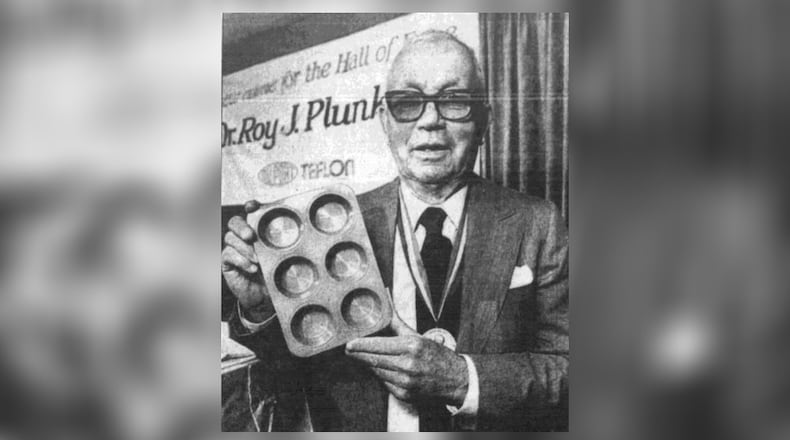Growing up
Plunkett was born in New Carlisle in 1910. A year later, the family moved to a farm near Ludlow Falls, where they lived until about 1925, when they moved to a farm along the Stillwater River west of Pleasant Hill.
“I enjoyed my life pretty much growing up there,” he once said. “During the last few years I was home with my parents, they lived along the Stillwater River and I enjoyed that very much.”
He took up interest in science at Newton High School, graduating in 1927.
“I got a little bit stirred up with science by a high school teacher — Mr. White, a science teacher,” Plunkett said.
College years
After high school, Plunkett enrolled in Manchester College in North Manchester, Indiana.
Upon graduation in 1932 with a B.A. in Chemistry, Plunkett faced “the bottom of the Depression” and decided to stay in school.
“There was nothing else I could do,” he said. “I did manage to get a few dollars together and go over to Ohio State University and stick my nose in the chemistry building — and got out four years later.”
He received his master’s in 1933 and his Ph.D. in 1936, both from Ohio State.
DuPont
Plunkett then joined DuPont as a research chemist at the Jackson Laboratory in Deepwater, New Jersey in 1936.
Less than two years later, he made his discovery of Teflon.
Accidental discovery
In 1938, Plunkett was in the lab, preparing a large cylinder of gaseous tetrafluoroethylene in hopes that it would prove to be a non-toxic refrigerant.
“But it turned out that it turned into a solid in the cylinder,” he said.
Tests showed the polytetrafluoroethylene was more inert than sand, not affected by strong acids, bases, heat or solvents — and could be produced on demand.
The famous trade name was not immediately given to the waxy white resin.
“So they gave it a name. The ‘tef’ was for tetrafluoroethylene and DuPont used “lons” in a lot of words it made up for its materials,” Plunkett said.
• RELATED: 10 inventors who changed the world from the Dayton region.
Military secret
Initially, Teflon was almost discarded because it didn’t have any military value.
Then, scientists working on the Manhattan Project during World War II found it to be an ideal material for gaskets that would resist the corrosive effects of uranium hexafluoride, a gas created during the production of enriched uranium in the atom bomb.
Teflon was a military secret until after the war.
It wasn’t until the 1950s that the coating became popular for domestic use , first on muffin tins, then frying pans.
“But it got zillions of uses by now,” Plunkett said in 1991. “There is no walk of life or industry, actually, that you don’t run up against it.”
Later career
In the wake of his Teflon discovery, Plunkett was promoted to chief chemist in 1939, to director of research of the DuPont Freon Products Division in 1960, and to director of operations of the Freon Products Division in 1970.
Later in his career, Plunkett was the chief chemist involved in the production of tetraethyllead, an antiknock agent that made gasoline “leaded,” later discontinued over concerns about the toxic effects of lead.
He also directed the production of Freon, DuPont’s brand name for chlorofluorocarbon refrigerant.
Plunkett worked to form many new products and processes used in the refrigeration, aerosol, electronic, plastics, and aerospace industries, many of which were used in the area of national defense.
He retired from DuPont in 1975.
Plunkett was inducted to the National Inventors Hall of Fame in 1985.
About the Author




